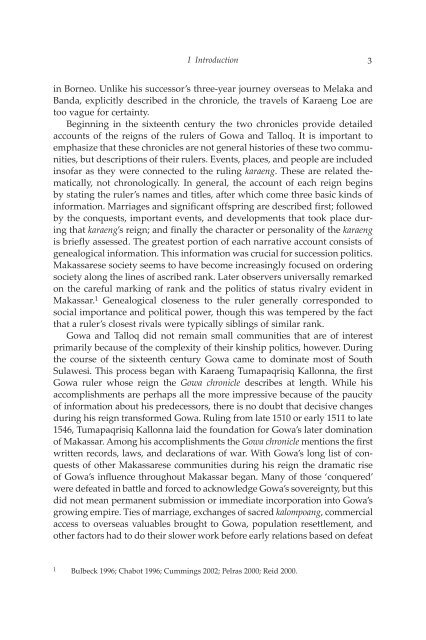A CHAIN OF KINGS - Books and Journals
A CHAIN OF KINGS - Books and Journals
A CHAIN OF KINGS - Books and Journals
You also want an ePaper? Increase the reach of your titles
YUMPU automatically turns print PDFs into web optimized ePapers that Google loves.
I Introduction 3<br />
in Borneo. Unlike his successor’s three-year journey overseas to Melaka <strong>and</strong><br />
B<strong>and</strong>a, explicitly described in the chronicle, the travels of Karaeng Loe are<br />
too vague for certainty.<br />
Beginning in the sixteenth century the two chronicles provide detailed<br />
accounts of the reigns of the rulers of Gowa <strong>and</strong> Talloq. It is important to<br />
emphasize that these chronicles are not general histories of these two communities,<br />
but descriptions of their rulers. Events, places, <strong>and</strong> people are included<br />
insofar as they were connected to the ruling karaeng. These are related thematically,<br />
not chronologically. In general, the account of each reign begins<br />
by stating the ruler’s names <strong>and</strong> titles, after which come three basic kinds of<br />
information. Marriages <strong>and</strong> significant offspring are described first; followed<br />
by the conquests, important events, <strong>and</strong> developments that took place during<br />
that karaeng’s reign; <strong>and</strong> finally the character or personality of the karaeng<br />
is briefly assessed. The greatest portion of each narrative account consists of<br />
genealogical information. This information was crucial for succession politics.<br />
Makassarese society seems to have become increasingly focused on ordering<br />
society along the lines of ascribed rank. Later observers universally remarked<br />
on the careful marking of rank <strong>and</strong> the politics of status rivalry evident in<br />
Makassar. 1 Genealogical closeness to the ruler generally corresponded to<br />
social importance <strong>and</strong> political power, though this was tempered by the fact<br />
that a ruler’s closest rivals were typically siblings of similar rank.<br />
Gowa <strong>and</strong> Talloq did not remain small communities that are of interest<br />
primarily because of the complexity of their kinship politics, however. During<br />
the course of the sixteenth century Gowa came to dominate most of South<br />
Sulawesi. This process began with Karaeng Tumapaqrisiq Kallonna, the first<br />
Gowa ruler whose reign the Gowa chronicle describes at length. While his<br />
accomplishments are perhaps all the more impressive because of the paucity<br />
of information about his predecessors, there is no doubt that decisive changes<br />
during his reign transformed Gowa. Ruling from late 1510 or early 1511 to late<br />
1546, Tumapaqrisiq Kallonna laid the foundation for Gowa’s later domination<br />
of Makassar. Among his accomplishments the Gowa chronicle mentions the first<br />
written records, laws, <strong>and</strong> declarations of war. With Gowa’s long list of conquests<br />
of other Makassarese communities during his reign the dramatic rise<br />
of Gowa’s influence throughout Makassar began. Many of those ‘conquered’<br />
were defeated in battle <strong>and</strong> forced to acknowledge Gowa’s sovereignty, but this<br />
did not mean permanent submission or immediate incorporation into Gowa’s<br />
growing empire. Ties of marriage, exchanges of sacred kalompoang, commercial<br />
access to overseas valuables brought to Gowa, population resettlement, <strong>and</strong><br />
other factors had to do their slower work before early relations based on defeat<br />
1<br />
Bulbeck 1996; Chabot 1996; Cummings 2002; Pelras 2000; Reid 2000.









![Am HaSefer [Volk des Buches] - Books and Journals](https://img.yumpu.com/20648352/1/174x260/am-hasefer-volk-des-buches-books-and-journals.jpg?quality=85)







